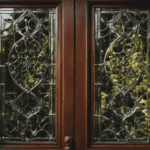
Image showcasing the difference between active and stationary French doors
Welcome to our guide on active and stationary French doors!
Picture this: you’re standing in your home, longing for elegance and functionality. That’s where French doors come in.
These beauties consist of two door panels, one that swings open (the active side) and one that remains fixed (the stationary side). With handles, hinges, and the ability to open and close, the active side steals the show.
But don’t overlook the stationary side. It is perfect for adding a touch of style or dividing rooms.
Let’s dive in and uncover the ins and outs of active and stationary French doors!
\
Key Takeaways
- Active French doors have handles, hinges, and the ability to open and close, while stationary French doors are fixed and cannot be opened or closed.
- The stationary side of French doors is usually secured with bolts or latches.
- French doors add versatility, aesthetics, natural light, and ventilation to any space.
- Consider your space’s layout, patterns, and aesthetics when choosing between active and stationary doors.
Get the Inside Scoop: Active vs. Stationary French Doors
If you’re wondering how to distinguish between active and stationary French doors, look for the handles, hinges, and ability to open and close on the active side.
The active side of the French door is the one that is designed to be operated, allowing you to enter and exit your home or patio quickly. It typically has a handle or knob that you can grasp to open and close the door and hinges that allow it to swing in and out.
On the other hand, the stationary side is fixed in place and cannot be opened or closed. It is usually secured with bolts or latches to keep it stable.
Consider your space’s layout and use patterns when choosing between active and stationary French doors. A functional door for easy access may be more practical if you have a high-traffic area. However, a stationary door may be better if you have limited space or want a more symmetrical look.
Double the Door, Double the Appeal: An Introduction to French Doors
Double the door, double the appeal: French doors provide an elegant and flexible option for creating a wide opening with natural light and indoor-outdoor flow. With two door panels hinged together, French doors offer a stylish solution for enhancing the aesthetics of any space.
Here are three reasons why French doors are a popular choice:
- Versatility: French doors can be installed in various locations, including patios, porches, and entryways. Their flexible installation options make them a versatile choice for any home.
- Aesthetics: The elegant design of French doors, with their glass panes, adds a touch of sophistication to any room. They allow natural light to flood, creating a bright and inviting atmosphere.
- Ventilation: Unlike sliding doors, French doors can be fully opened, allowing maximum airflow and ventilation. This makes them ideal for spaces that require good air circulation.
Whether you’re looking to enhance the functionality of your patio or add a touch of elegance to your entryway, French doors are a stylish and practical choice.
The Operating Door and The Fixed Panel
When choosing which side of the door to open and close, we must consider the handles, hinges, and ability to open and close.
The active door is the one that operates, allowing us to enter and exit. It is mounted on the hinge side and has handles, latches, locks, and motion.
On the other hand, the stationary door is fixed with no motion.
When deciding which side should be active or stationary, we should consider the room layout, traffic flow, and use patterns. The hinge side is better for tight spaces and is the main entry/exit. If we place the active door on the opposite hinge, we can preserve walkway access when closed.
It is important to note that handles and locks are only needed on the active side, while the stationary side can have matching dummy hardware.
For those looking for optimal climate control, out-swing French doors are recommended.
French Door Pro in No Time
Once you understand the key differences between the two sides, selecting the correct configuration for your space becomes easy. With our insights, you’ll soon be a French door pro. Here are some tips to help you on your way:
- Consider the layout: Look closely at your space and think about how you want the doors to function. Do you need one side to be operational for easy outdoor access? Or are you looking for a more symmetrical, stationary setup?
- Think about use patterns: How will you be using the space? If you frequently entertain and want a seamless transition between indoors and outdoors, an active side may be the way to go. On the other hand, if you’re looking to let in light and enjoy the view, a stationary side might be a better fit.
- Take aesthetics into account: French doors can be a stunning focal point in any room. Consider your space’s overall design and style when choosing between active and stationary sides. You want the doors to blend seamlessly with the rest of your decor.
Are Retractable Screens Compatible with Both Active and Stationary French Doors?
Yes, retractable screens for French doors are compatible with both active and stationary French doors. These innovative screens provide a versatile solution for keeping bugs out and allowing fresh air in, while seamlessly blending with the design of any French door.
Are Active or Stationary French Doors More Resistant to Wind?
When it comes to stopping French doors wind blown, both active and stationary French doors can be resistant. Active French doors with multi-point locking systems offer enhanced security, while stationary French doors provide added stability against strong winds. Proper installation and high-quality materials are key factors in improving wind resistance.
Frequently Asked Questions
Can I Change Which Side of the French Doors Is the Active Side?
Yes, you can change which side of the French doors is active. Switch the handles, hinges, and ability to open/close. Consider layout and use patterns to determine the best configuration.
What Are Some Common Design Options for French Doors?
Some standard design options for French doors include various materials such as wood, metal, or fibreglass and different panel configurations like single or double. The choice depends on personal style and the overall aesthetic of the space.
Are French Doors Suitable for Both Interior and Exterior Use?
Yes, French doors are suitable for both interior and exterior use. They offer a beautiful and functional option for connecting spaces and allowing natural light to flow. Consider layout and usage patterns when deciding on active or stationary panels.
How Do French Doors Compare to Other Types of Doors in Terms of Energy Efficiency?
French doors are typically less energy efficient than other doors due to the large glass panels. However, choosing energy-efficient glazing, proper weatherstripping, and insulation can help improve their energy performance.
Are There Any Special Maintenance Requirements for French Doors?
There aren’t any special maintenance requirements for French doors. However, it’s important to regularly clean and lubricate the handles, hinges, and tracks. Inspect for any damage or wear and make necessary repairs.

I’m James Davis, a carpenter with eight years of experience in carpentry services, repairs, installations, renovations, and maintenance of interior doors. I have a diploma in carpentry and joiner trade from the Education Skills Australia Institute and take pride in delivering high-quality results to ensure customer satisfaction. I’m a blog writer for Octopus Doors Company and enjoy sharing my knowledge and tips on maintaining security measures and choosing the right door materials, paints, or handle styles. I specialize in custom-made interior doors and strive to make every home look fabulous. Contact me anytime for help with door-related issues.










